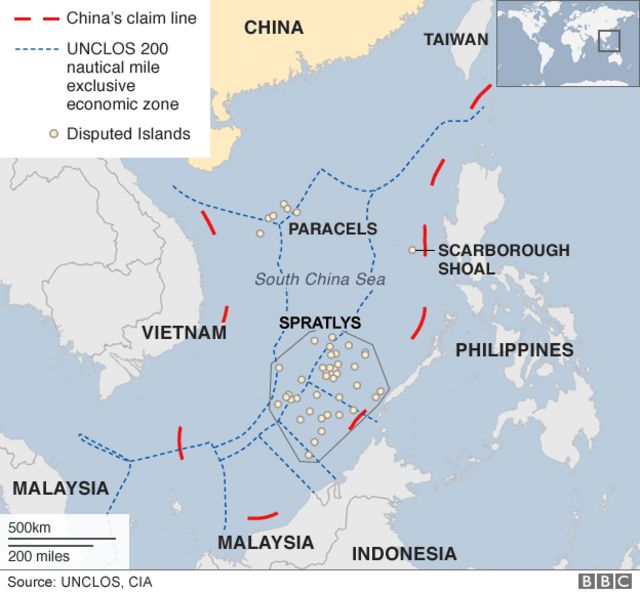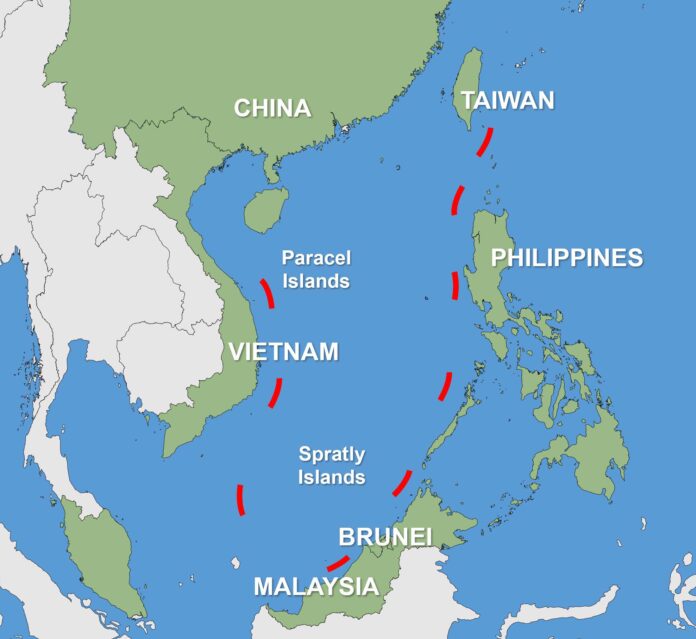The South China Sea is one of the most important economic and environmental regions in the world. More than half of the world’s fishing vessels are in the South China Sea. Millions of people depend on these waters for their food and livelihoods. But the South China Sea has been dangerously overfished. Many overlapping and interconnected disputes over who owns the various islands, rocks, shoals, and reefs scattered throughout the South China Sea waters also exist.
Maritime disputes in the South China Sea (SCS) have been ongoing for the past 60 years. Six countries claim different parts of three island chains and their associated maritime zones. The Spratly Islands, which consist of more than 200 small islands, coral reefs, and shoals, lie at the centre of heated diplomatic exchanges among the Philippines, Vietnam, Malaysia, China, and Taiwan. These countries holds some control over the island chain. China, Vietnam, and Taiwan claim the Paracel Islands.

A portion of the islands have been under Beijing’s authority since the 1950s, and a brief battle with Vietnamese forces in 1974 allowed China to firmly establish its control over the entire archipelago. Furthermore, the Scarborough Shoal is a point of contention for sovereignty between China, the Philippines, and Taiwan.
The United States has stated support for an agreement on a binding code of conduct and other confidence-building measures since it still has significant interests in maintaining freedom of passage and securing maritime lines of communication (SLOCs). SLOCs are crucial maritime routes that aid in trade and the movement of naval troops, but China’s claims put them in danger.
The United States played a role in preventing military escalation resulting from the territorial dispute. Washington’s defence treaty with Manila could draw the United States into a potential China-Philippines conflict. The conflict is over the substantial natural gas deposits or lucrative fishing grounds in disputed territory.
The failure of Chinese and Southeast Asian leaders to resolve the disputes by diplomatic means could also undermine international laws governing maritime disputes and encourage destabilising arms buildups.
Beijing expanded the ability of its military to intimidate its neighbours by constructing a number of islands in the South China Sea. Over the past eight years, China has excavated and reclaimed thousands of square feet in the SCS. These man-made islands are home to high-tech infrastructure, such as loading piers, support structures, runways, and satellite communication antennas.
The main reason why Chinese military buildup is upsetting the United States and its Indo-Pacific allies is the region’s reliance on SCS resources to feed and support its people. China’s capacity to impact the global economy was enhanced by Beijing’s SCS measures.
Realism is key to understanding why China is asserting its claims throughout the SCS. A centralised authority does not govern the SCS; therefore, the region is present in an anarchical system.
The United Nations Convention on the Laws of the Sea (UNCLOS) establishes a legal system for the sea, but it lacks any enforcement procedures for the rules it sets down. China is using its military, economic, and diplomatic might to force Beijing’s neighbours and the international world to accept the SCS status quo without facing any legal implications. To counter Beijing’s expanding regional military capabilities, China’s neighbours are stepping up their military spending and contacting the US.
Southeast Asian countries are more dependent on the SCS’s resources for their people’s well-being than China, which makes their access to the waterways critical to maintaining internal stability and ensuring the survival of their political structures.
Even as tensions continue to rise, SCS countries’ sensible behaviour serves as another example of realism. When Manila opposed Beijing over its shoals, the Philippines served as a perfect example of realism. Despite some states’ best efforts to cooperate within the international legal system, the region’s nations have a perilous atmosphere that could lead to open conflict and spark a worldwide economic disaster due to endemic mistrust and soaring military spending.
To improve interoperability and send a message to China that its neighbours want a peaceful resolution to SCS conflicts, Washington could invite additional Indo-Pacific states with interest in the SCS, such as Japan, Australia, South Korea, and India—into these drills. A benign signal to China of Washington’s desire to amicably resolve the region’s maritime conflicts may be sent by the US Navy making port calls to the countries involved in maritime disputes.
Since the fishing industry employs and feeds a vast majority of the Indo-Pacific population, Washington should assist the region in building a framework to allocate SCS fisheries. The United States may start by encouraging the claimant states to negotiate agreements for establishing fishing grounds that enable fishermen to continue to fish in their waters without harassment.
Organizing a regional conference at which ASEAN, the US, China, Australia, and India would decide on the steps necessary to reduce tensions in the SCS and foster trust would be the first step. Beijing should make the bases on its SCS islands joint bases so that the group of countries may set up international coordination hubs to deconflict military movements. The nations might cooperatively monitor the region’s fisheries from the aforementioned coordination centres and engage in co-development of hydrocarbon resources in parallel with increasing military cooperation.


